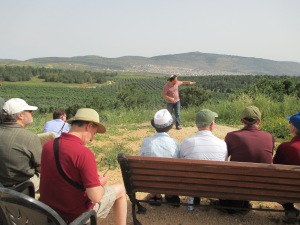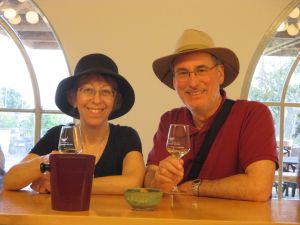
We started the morning by visiting Kibbutz Hannaton in the Galilee, a remarkable place that is dedicated to thinking about what an Israeli identity that meets the complexities and challenges of the modern state should look like. Its Executive Director, Rabbi Yoav Ende, spoke about the original kibbutz pioneers who built up the land, driven by a mission of creating a Jewish state and a vision of a homeland that Jews could call their own. In our time, Ende said, Israelis have lost a coherent sense of mission and so a new generation of pioneers must help to forge an understanding broad enough to include young and old, religious and secular, and compelling enough to keep Israelis connected to a country full of dangers and challenges. In this sense, Ende echoed Israeli author and thinker Ari Shavit, whose remarkable and challenging book My Promised Land I encouraged everyone on the trip to read and which concludes that Israel can only find the strength and will to overcome its external challenges (Palestinian nationalism, radical Islam, an Iranian nuclear threat, increasing marginalization on the global stage) if it can find a way to address its internal challenges (segmentation and division among Israeli Jews, division between Israeli Jews and Israeli Arabs, the rise of an individualistic ethos that undermines shared sacrifice and purpose). The way he put it was, “Politicians are thinking so much about what will be the borders of a future Israel, but we need to care about what lies within those borders.”
We stood on the edge of the kibbutz overlooking the Arab town of Kfar Manda and the Bedouin village of Bir el-Maksur. The Galilee is the one region in Israel where Israeli Jews and Israeli Arabs live in close proximity (more on that tomorrow) and Hannaton is trying to forge relationships with its neighbors, working together on shared projects and having kibbutz members serve as volunteers in the Arab communities. As part of this project of building a new Israeli identity, Hannaton accepts forty Israeli eighteen-year olds as part of a highly selective and prestigious year of study and leadership training before the army, which includes engaging the issues I’ve mentioned and having graduates bring their training and their sensibilities into the army, building this new community in the best pioneering spirit. Another aspect of Hannaton’s principle of inclusion is a commitment to pluralism, which is still a very unusual and suspect idea in Israeli society, even as it is long settled in America. As part of their work one key initiative in the past few years was opening a community mikveh (ritual bath) – the first one in the country that isn’t run under Orthodox auspices. All in all, the kibbutz represents a visionary and ambitious project that is vital to renewing Israeli society.
The divisions in Israeli society, by the way, were on display that same morning as Anat Hoffman and Women of the Wall succeeded for the first time in reading from a full-sized Torah scroll into the women’s section at the Kotel as they gathered for services for Rosh Chodesh. Anat had revealed the plan to us when we met with her last week but had made us promise not to write about it because it is illegal(!) to bring the Torah into the women’s section and involved a fair amount of subterfuge. Unsurprisingly, the initiative lead to scuffles and arrests but was also an important milestone in the fight for equality and shows how much work still needs to be done.

From Hannaton we went to Tzfat, center of the kabbalist movement in Israel, beginning in the 16th century. We walked the ancient streets and visited one of the synagogues of the Ari, Rabbi Isaac Luria, who developed a new version of Kabbalah, and the synagogue of Rabbi Joseph Caro, codifier of the seminal book of Jewish law the Shulchan Aruch. On our way down into the valley we looked out over the fields where the mystics went out to greet Shabbat singing a brand new song of their own composition, Lechah Dodi. From there we headed into the Golan, whose vital strategic importance has only been underscored

by the ongoing civil war in Syria, and we visited the Ramat Golan Winery for a tour and tasting, which came in very handy for our next stop, at a fish restaurant on the shore of the Sea of Galillee where we enjoyed our wine purchases as we watched the crescent moon of the new month of Iyyar rising over the Sea of Galilee.

Hi Mom! Hi Dad! Looks like a tough day for you!
LikeLike
What a great itinerary! I want to hear more about kibbutz hannaton! Did you taste any wine there too? 🙂
LikeLike